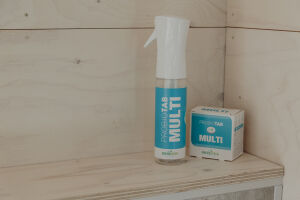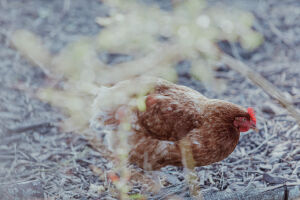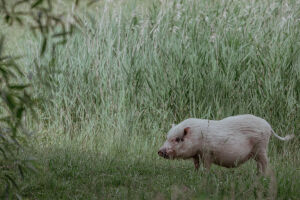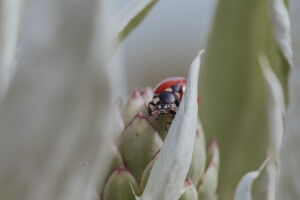SUSTAINABILITY
POLICY
ONS BUITEN's sustainability program originated from our own development process. We notice that it is a combination in which the small choices, such as switching to ecological cleaning products and replacing garden tiles with plants and more biodiversity, are just as important as the more impactful decisions, such as investing in depth in energy and switching on a plant-based diet.
That's how it is with ONS BUITEN. It is a continuous process, in which we also look at how we can create space to let colleagues and guests make their own sustainable choices. We also work with partners who bring about similar changes. For example, together with landscape developer Jos Willemsen, from Teaming with Life, who is working on a more powerful nature on the site with both large and small steps.
INTRINSIC CHANGE
We believe that all sustainable change processes come from within the organization, but also from within people. That goes step by step. Not everything can be done at once, or according to a certain method, because then it will not match the personal experience and motivation. Moreover, a step-by-step process proves to be very valuable to us, because it gives us the opportunity to immediately implement progressive insights.
NATURAL PACE
We have many ideas for the future and a far-reaching sustainable vision, but we can only take every step towards that properly if we are really ready for it.
Sometimes people are clearly at the beginning of a concrete awareness process. In other cases, people may have been used to a more natural form of life for a longer period of time. Or people only choose to contribute every now and then. Everyone experiences for themselves how one personal choice gives space to another. And every step counts.
For example, we have jut (beachcomb) barrels, with which children can collect shells, beautiful stones, and other finds from nature. At the same time, we see that the barrels are also spontaneously used to clean up litter.
INDEPENDENT AND (GREEN KEY) RECOGNIZED
We give as much room as possible to autonomous decisions. Both on an individual and company level. By constantly consciously looking for what is best for us. We are independent in that. This also applies to the transition to increasingly sustainable choices.
However, quality marks do ensure recognisability. Among other things, we have the highest (GOLD) classification of the leading GreenKey label. And we have been nominated for the ADAC Camping Awards 2022, in the category 'sustainability and environmental awareness.
We experience these recognitions as a token of appreciation that is in line with the guidelines established and tested by experts for an effective sustainability transition.
EXAMPLES
We are convinced that everyone can make an important contribution and we no longer want to run away from our own responsibilities. Once we entered the road on a more sustainable path, there was no turning back for us. That is why we are committed to a complete transition with as many concrete steps as possible.
LANDSCAPE & ECOLOGY
We look at the creative capacity of nature and work with it as much as possible ('teaming with life'). This goes beyond the (closed) circular idea of energy conservation. In fact, we see that the soil and the vegetation on it become more and more fertile, more productive, and more and more biodiverse when they are given the opportunity to attract and accumulate even more energy as unimpeded as possible. In which the new grow in the improved conditions of the previous.
SOIL IMPROVEMENT
Of course, we don't do active fertilizers. But only harvest existing biomass and then transfer it to the soil (mulching). This makes it an enrichment, and not just a 'giving back', because the biomass is not only made up of nutrients that come from the soil but also (eg through light) from the cosmos.
PRUNING POLICY
We do not weed at ONS BUITEN, but harvest, which we use to further enrich the (soil) system. By cutting off the unwanted plants above ground with a scythe or sickle. We use the mulch as absorbable food by transferring it to the soil. We prefer to do this at times when the energy present in the greenery is greatest. As a result, the soil and ecosystem are increasingly enriched. It is, therefore, possible that harvesting/pruning takes place at times that are not synchronized with the generally known times.
PLANTING (FOOD & HERBS)
We use many food-producing crops and herbs, which is why OUR OUTSIDE is slowly developing more and more as a food forest. We work together with nature, for example by making smart plant combinations. And we use a lot of ground covers, so we don't have to fight with unwanted plants.
HEDGES AND GREEN
Homogeneous hedges (mostly privet) have been replaced by a variety of trees, shrubs and plants. This contributes to the natural landscape and biodiversity.
ANIMALS
We imitate a nomadic life as much as possible for Max&Ruby pigs and the chickens with changing meadows and a mobile run. In this way they can temporarily stay in a certain place, so that healthy patterns of 'turning up', 'fertilization' and 'recovery' take place. These are natural processes that ensure optimal soil conditions.
More about this: https://www.teamingwithlife.info/watissyntropischelandbouw
PATHS & PADDING
Tile terraces and other use of soil-covering structures and materials will be replaced where possible by permeable pavements that can grow through. Asphalt is gradually replaced by semi-paving, whereby the asphalt is recycled.
Why asphalt was deliberately chosen for the entrance.
LIGHT POLLUTION
In the middle of the darkest area of Zeeland, we limit the amount of light pollution to a minimum. That is why we use as few fixtures as possible, we focus as much as possible on no-tech solutions and we apply very weak, but safe directional lighting.
We are also investigating the possibility of safely setting zero-light times, in which artificial light is extinguished, and/or whether lamps with light frequencies that are not harmful to birds and insects could offer an additional solution in the fight against light pollution in the future.
(RAIN) WATER
WATER PLAYGROUND (2020)
The demolition of the former indoor swimming pool with paddling pool created space to create an outdoor water playground in addition to the circular pool and wellness building, which would offer children an ideal opportunity to independently discover different elements of nature.
The natural construction of a water-mud playground that we had visualized for ourselves turned out not to exist ready-made. Together with partners from tree house construction and our landscape designer Jos Willemsen, we have designed and manufactured a water-mud playground that is as natural as possible. The outcome is a unique water-mud playground in the form of a spiral with opportunities for creative play for all ages, which of course comply with the strict safety regulations and standards that apply to playgrounds.
CASCADES (2020)
Three water cascades have been constructed in part of a former ditch, where the water is kept clean by means of a pump system and filtering by EM bacteria.
The water from the cascades is used for the water-mud playground and the water in the wellness garden. At both locations, a conscious choice has been made for (soft) flowing water to keep the water safe and healthy, while also generating an energetic (and emotional well-being) benefit.
WADIs (2021)
The construction of a 'cushioned landscape' in combination with the semi-paved camping pitches (can be rented out all year) have been created between the lanes of wadis where excess rainwater can slowly infiltrate into the soil. This allows us to retain the water for a longer period of time, so that plants can still benefit from it during dry periods and we no longer need to apply active drainage. In addition, the decoupling of rainwater relieves the sewer system and thus saves energy in the water purification process. Moreover, wadis are beneficial for insects, reptiles and (small) mammals and therefore beneficial for biodiversity.
NEW CONSTRUCTION AND RENOVATION
Circularity in construction is a priority for us. The three-to-five-year goal that we set is to build or renovate all new buildings in an optimal circular manner. The realization of the WELLNESS & POOL (2019) has set a first high standard on which we can literally build further.
We are currently processing the lessons learned to design and realize new accommodations that are manufactured even further according to circular construction principles. This is how we look at:
FLEXIBILITY AND FUTURE RESISTANCE
It is important not only from a circular point of view but also from the operational point of view (Total Cost of Ownership) to consider the entire life cycle of the building. The structure of the building is flexible in nature. Based on the 7S-Layers-of-Change model, the building has been constructed in such a way that it can easily be adapted to changing needs in the future. By preventing, for example, the need for heavy constructive adjustments in the event of a change in the building and by keeping facade elements demountable, we avoid unnecessary waste (and therefore 'waste') at a later time.
REUSE OF RAW MATERIALS
The objective of eliminating the production of 'waste' is important in circular construction. When choosing materials, it is important to look at recycled materials in the new building. For example, the WELLNESS & POOL building is the first circular swimming pool in the Netherlands, for example by using materials from the port of Veere.
In addition, it is important to look at how all materials used can be reused later, for which the materials passport is used.
ENERGY SAVING
Based on the philosophy behind Trias Energetica, we looked at how we can make buildings as compact and (energy) efficient as possible.
WASTE & RAW MATERIALS GENERAL
We do not believe in waste, but in raw materials. In doing so, we look at minimizing energy loss during the transition from waste to raw material and at optimizing the quality of applicability (for recycling and upcycling). This makes us pioneers in smart cycling.
BOKASHIA
Depots are being built for the organic waste raw materials from the catering industry, and green harvest. Camping guests are invited to make their own contributions by separating personal GFT raw materials. We make bokashi from all these green residues. An anaerobic fermentation process that converts green waste into a high-quality soil improver.
ENVIRONMENTAL STREET / COLLECTION
The layout of our recycling center for the collection of raw materials has been adapted to make it easier for guests and to help raise awareness about raw materials (by offering interesting information). We are already seeing that the better separation of raw materials is increasing, which is why, among other things, the PDM container has been replaced by a larger container. Read more about the collection of raw materials here.
CLEANING PRODUCTS
From the 2022 season, we will offer guests the opportunity to take care of their final cleaning in a responsible manner.
The internal cleaning of all departments is continuously made more sustainable through the use of better resources and less energy. Read more about the collection of products that are used for a clean and healthy living environment.
EAT DRINK
The production and transport of food are a major burden on the environment. By finding a balance between a varied and attractive offer and sustainable options for our guests, we also shape the sustainability transition in this area.
REGIONAL & ORGANIC (2019)
As much as possible, we enter into long-term partnerships with food producers in the region that carry an organic label.
PET & FISH FREE (2021)
The menu is completely animal- and fish-free, but not (yet) 100% vegetable. There are, however, regular food trucks on the site that supplement the offer and choice.
Togo
We are committed to a zero-waste strategy, whereby the current paper single-use items will eventually be replaced by reusable packaging because it appears that the current waste streams are not yet fully suitable for the degradable packaging to be included in the VGF waste stream. that's why we want to move to reusable.
However, our to-go packaging in the catering industry has been fully biodegradable for longer than legally required. We also constantly consider whether it is also a way to leave something out: no straws or biodegradable straws.















